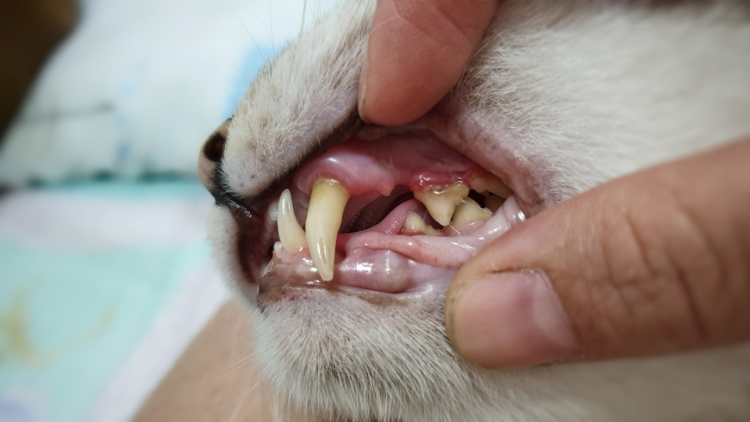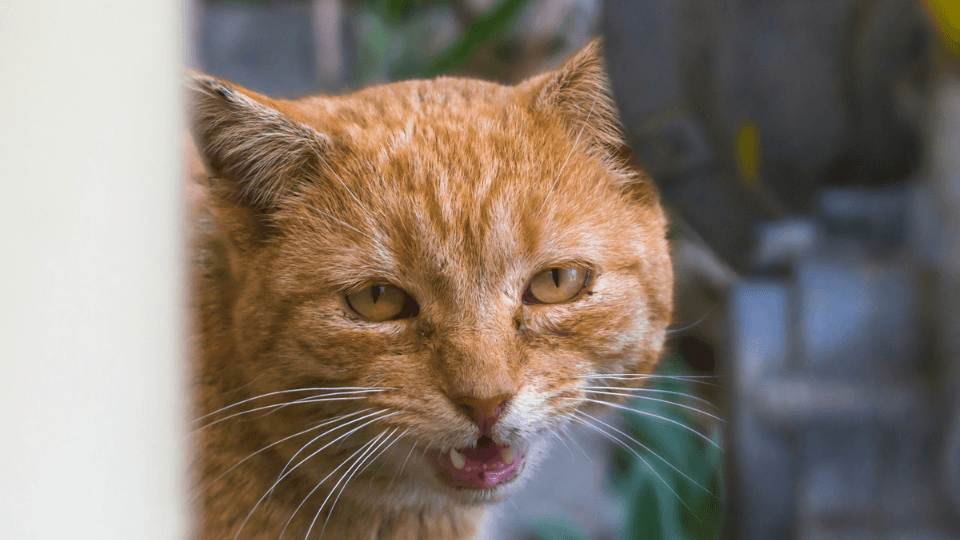Stomatitis in cats is an extremely painful, potentially fatal condition caused by ongoing inflammation inside the mouth. Unfortunately, the disease is prevalent in as many as 12% of the feline population in the United States and Europe.1
Most cats respond well to medical treatment, but surgery can be incredibly expensive without pet insurance, costing up to $3,000 to treat. We’ll go over the causes, symptoms, and treatment costs of stomatitis in cats, as well as preventive measures you can take to help your cat avoid this excruciating experience.
Table of Contents:
- What is feline stomatitis?
- What causes stomatitis in cats?
- What are the clinical signs of stomatitis in cats?
- How do vets diagnose feline stomatitis?
- How do you treat stomatitis in cats?
- How much does cat stomatitis cost to treat?
- What is the prognosis for cats with stomatitis?
- What can I do if my cat has stomatitis?
- Can you prevent stomatitis in cats?
What is feline stomatitis?
Feline stomatitis is a condition in which a cat (typically over one year old) has severely inflamed gum tissue that creates significant pain in the mouth. Otherwise known as feline chronic gingivostomatitis (FCGS), “stomatitis” referrs to the widespread inflammation of mucous membranes all throughout the mouth.
The generalized pain differentiates stomatitis from gingivitis in cats, a less severe but more common dental issue prevalent in felines. Another difference is that cat stomatitis often leads to painful oral lesions and ulcers that can form on the gums, lips, tongue, and back of the cat's throat.
What causes stomatitis in cats?
the exact cause of stomatitis in cats is unknown. Researchers aren't sure why it appears to affect some cats and not the others, but believe many cases to be immunologically-mediated, meaning that the cat's immune system assaults the tissues in its mouth as an aberrant reaction to oral germs.
There are several studies that suggest a link between stomatitis and certain diseases, specifically:
- Feline calicivirus
- Feline leukemia virus (FeLV)
- Feline immunodeficiency virus (FIV)
- Autoimmune disease
- Kidney disease
- Diabetes mellitus
The chronic inflammation is usually observed in adult felines, indicating a connection to age, while other data may point to a genetic link, as onset occurs earlier in certain breed types.2 Early-onset of feline stomatitis occurs in cat breeds like:
- Himalayans
- Somalis
- Persians
By comparison, gingivitis is the result of bacteria forming from food leftover food particles on the outer surface of cats' teeth known as plaque. Without adequate dental care for cats, the plaque buildup accumulates, mineralizes, and turns into tartar — a crusty, yellowish brown deposit that's much harder to remove than the soft, waxy biofilm created by plaque.
As the deposit spreads across the tooth and touches the gingiva (gums), or penetrates the gingival sulcus (the space between the tooth and the gum) it triggers an immune reaction in cats, seen as red, tender swelling in the gums near impacted teeth. If left untreated, it could lead to the loss of the tooth's supporting structures, known as periodontal disease.
However, feline stomatitis can also develop in pets without these health conditions due to various dental problems, like periodontal disease.
What are the clinical signs of stomatitis in cats?
Gingivitis causes bad breath, swelling of the gum tissue, and a thin red line along the line where the gum meets the teeth. The irritated gums typically bleed during cat dental cleanings.
Severe pain is one of the most typical stomatitis symptoms. In some cases, a cat with stomatitis could be in too much pain to open its mouth to feed. They may also display behavioral changes like becoming withdrawn or irritated due to chronic pain. Other symptoms of feline stomatitis may include:
- Bad breath
- Red and inflamed gums
- Excessive drooling
- Pawing at mouth or face
- Reduced appetite
- Difficulty swallowing
- Weight loss
- Lethargy
- Pain when their face is touched
- Unkempt coat because the grooming is too painful
Make sure you schedule an appointment with your veterinarian for a checkup if your cat is displaying any of the symptoms listed above.

How do vets diagnose feline stomatitis?
Veterinarians primarily rely on a comprehensive oral examination to identify stomatitis in cats. To check for any underlying systemic diseases, your veterinarian may perform routine bloodwork and targeted testing for diseases like FIV and FeLV. They might also order dental X-rays to check for the presence of periodontal disease, so you'll want to prepare your pet for anesthesia.
Because the oral pain makes the cat hesitant to open its mouth, it might be challenging to examine the mouth of a cat with stomatitis. To enable a more thorough and pleasant examination, your veterinarian may advise sedation.
How do you treat stomatitis in cats?
In order to successfully treat feline stomatitis, it is important to reduce the number of germs in the cat’s mouth. Some felines will respond to at-home oral care with dental gels or rinses (cats with stomatitis often have too much pain to tolerate tooth brushing) and routine dental cleanings under anesthesia.
However, even after a complete dental cleaning by their veterinarian, cats with stomatitis frequently have severe inflammation that either does not go away or comes back very fast.
The current suggested course of treatment is to remove some or all of the teeth, known as a partial or full-mouth extraction. Although this may seem like a drastic action, it is thought to be the most effective strategy to provide significant and long-term comfort for affected animals. Your veterinarian might refer you to a veterinary dentist because this operation can be extensive.
How much does cat stomatitis cost to treat?
Treatment costs for feline stomatitis vary depending on how well each cat responds to the prescribed course of action. Mild cases that are handled on a routine basis without being referred to a specialist can run you about $800 per year for repeated dental procedures.
Fortunately, many pet insurance plans include pet dental insurance. Be sure to utilize pet insurance comparison tools like Pawlicy Advisor to learn exactly what's covered by your plan.
Compare Pet Insurance For Cats Learn How Pet Insurance Works
What is the prognosis for cats with stomatitis?
Although stomatitis in cats can be challenging to cure and can even be fatal in some cases, many cats respond well to therapy. While non-surgical treatments are possible, cats typically need a combination of surgery and medication.
Two-thirds of cats with stomatitis that undergo full mouth extractions experience a “clinical cure,” meaning no further care is required; the remaining 33% of cats may need additional treatment to control the pain and inflammation, such as oral gels and more extractions.3
If the extraction(s) are unsuccessful, your vet might prescribe antibiotics and/or immunosuppressive medications. Many felines see improvement with these supportive measures.
How long can a cat live with stomatitis?
Felines with stomatitis can live with the condition for several years, but although with a significantly lower quality of life. The unrelenting pain and discomfort caused by the disease can have a negative impact on your pet’s behavior and attitude.
It could also make them reluctant to eat, which can result in significant weight loss. Cats who receive the right treatment for stomatitis, such as partial or full-mouth teeth extractions, lead happier, healthier, and pain-free lives.
What can I do if my cat has stomatitis?
If your feline friend has stomatitis, the best thing to do is to work with your vet to create a plan for when the animal can have the necessary teeth extracted. The discomfort and oral inflammation can be completely resolved by surgically removing the afflicted bone, but there are no other medications or treatments that can truly cure feline stomatitis.
Can you prevent stomatitis in cats?
Stomatitis is difficult to prevent. The best strategies to protect your cat are to keep up with regular vet visits and good dental care. Making sure your cat got all of the necessary first-year shots for kittens is crucial for preventing contagious illnesses that could cause stomatitis.
Most felines can avoid gingivitis by controlling their plaque, with daily tooth brushing being the most effective strategy. Plaque-controlling treats, chlorhexidine rinses, and water additives are less expensive but still have some effectiveness.
References
- PetMD, "Stomatitis in Cats" Accessed Oct. 12, 2022.
- ILoveVeterinary, "Stomatitis in Cats" Accessed Oct. 12, 2022.
- Blue Pearl Vet, "Stomatitis in Cats" Accessed Oct. 12, 2022.
